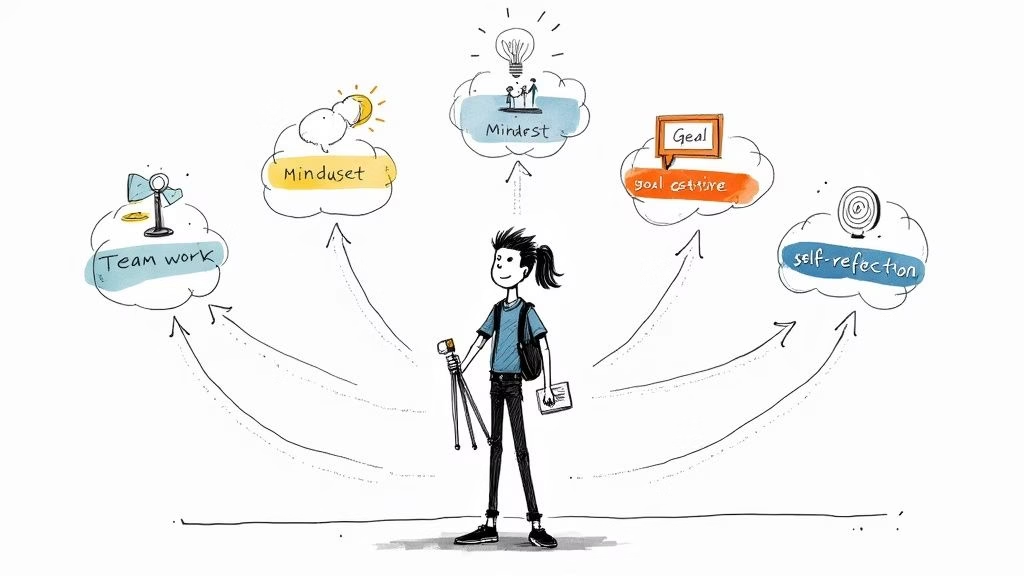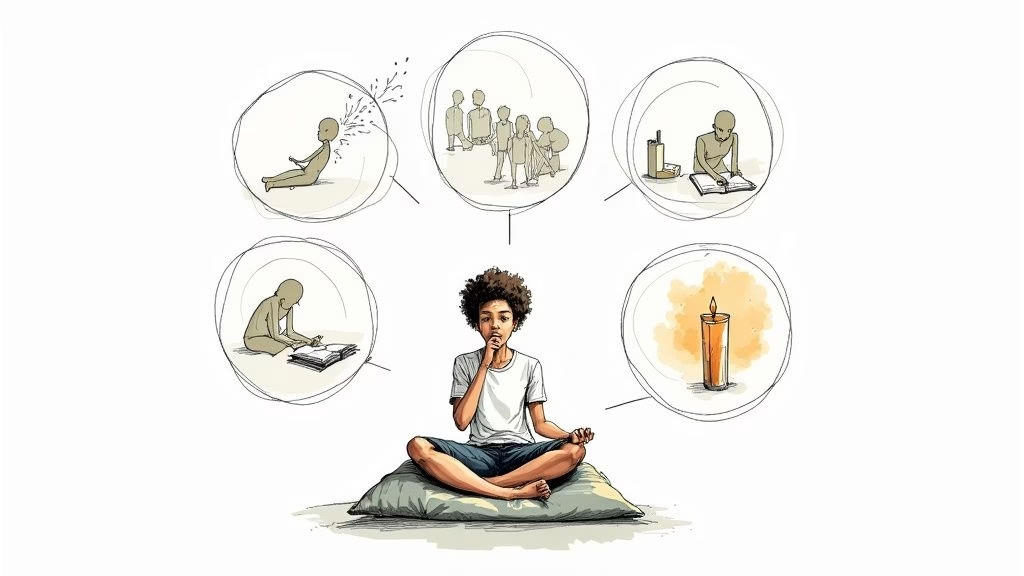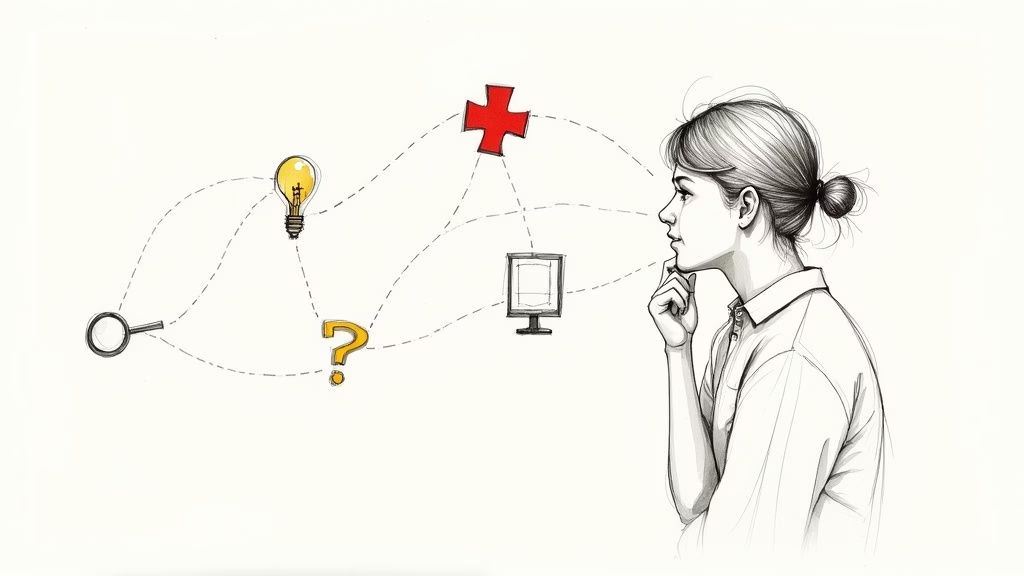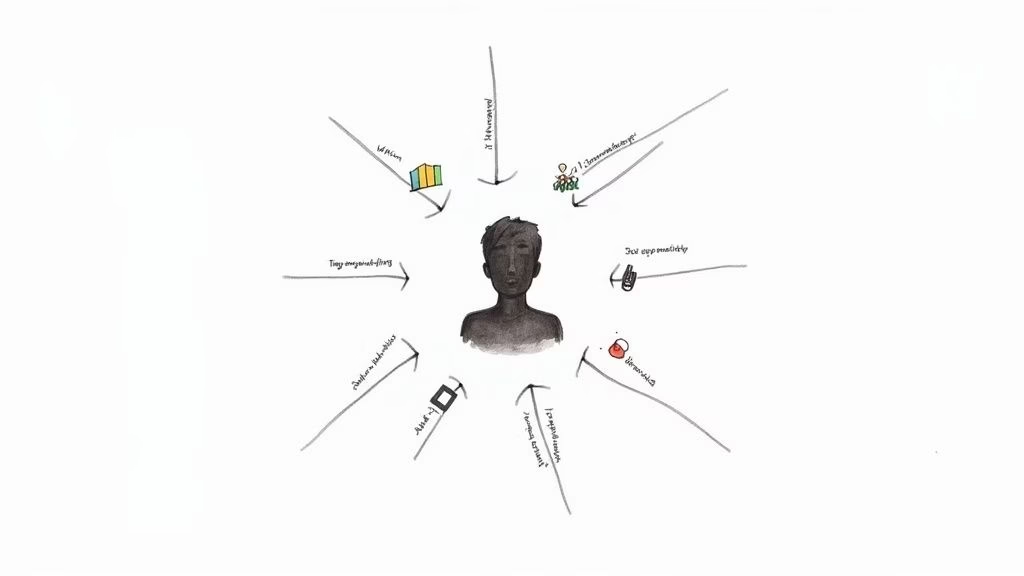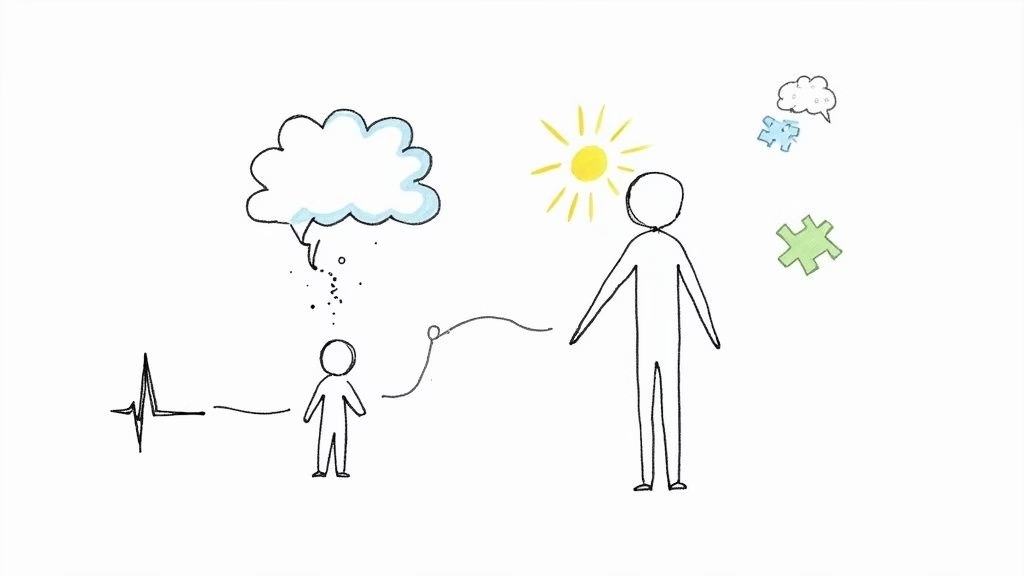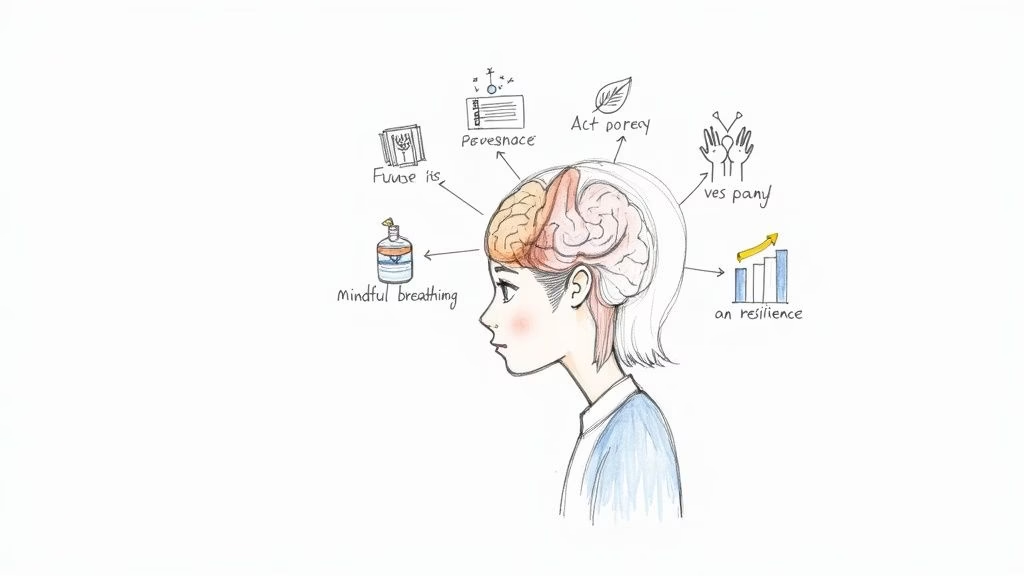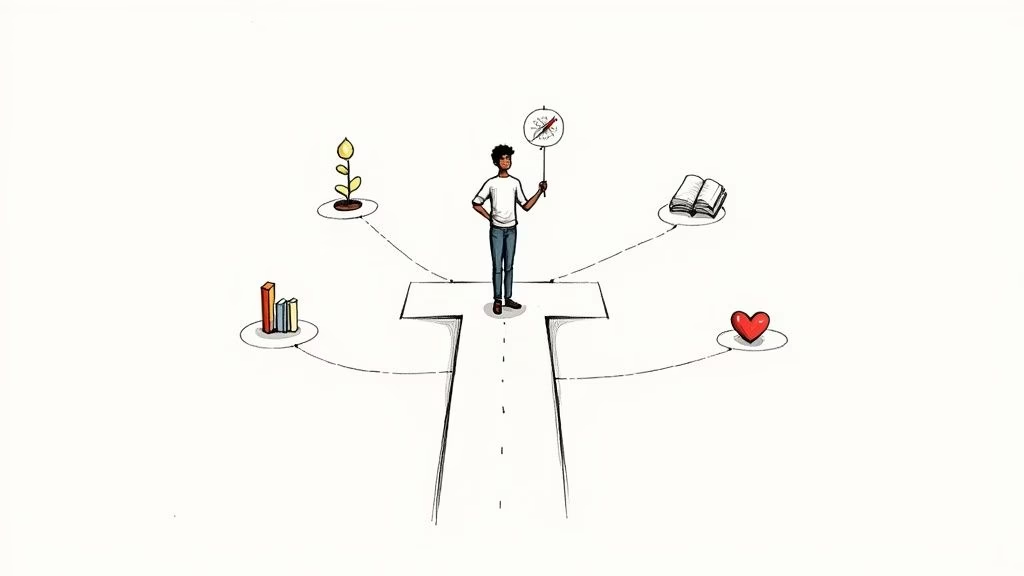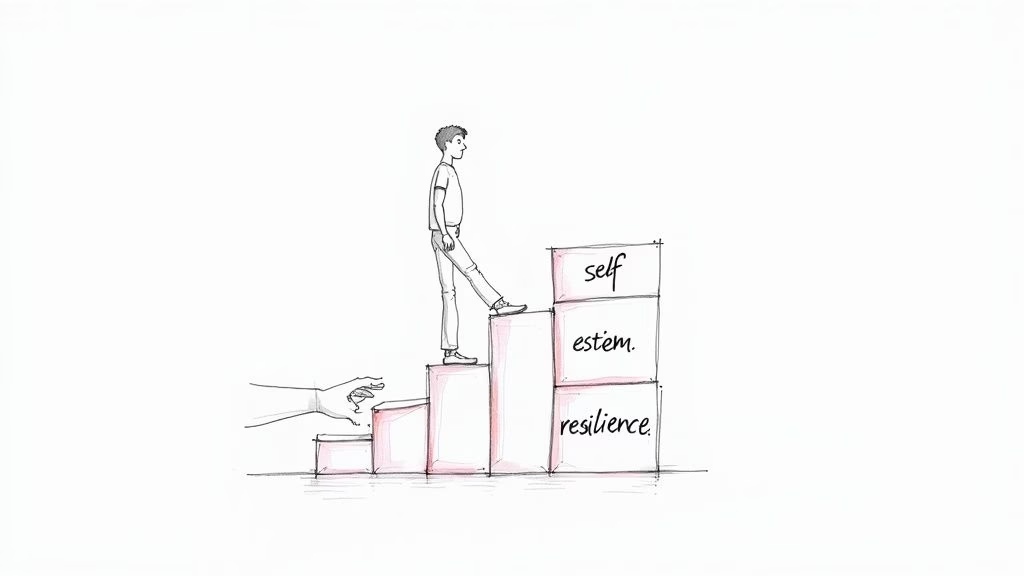The simplest way to think about the difference between Early Decision and Early Action is this: Early Decision (ED) is a binding commitment, while Early Action (EA) is a non-binding option. One is a marriage proposal to a single college; the other is like going on a few really promising first dates.
This one distinction changes everything. It dictates your freedom, your leverage with financial aid, and the entire strategy for your senior year.
Decoding Your Early Application Options
The college application journey can feel like a high-stakes race, and just deciding how to apply is one of the first big hurdles you’ll face. The choice between Early Decision and Early Action isn't just about getting your application in sooner; it's about commitment, confidence, and managing the emotional rollercoaster that is senior year. For a lot of students, procrastination and motivation become huge challenges during this time, and the path you choose can either add to the stress or relieve it.
This is a critical family conversation. Parents can help by framing the discussion around empowerment and finding the right personal fit, not just pressure to get in somewhere early. The goal is to make a thoughtful choice that aligns with your student's academic readiness and, just as importantly, their mental well-being. A good plan avoids that last-minute scramble that fuels so much anxiety. We break down how to structure these conversations in our complete guide on college planning for high school students.
Key Differences At a Glance
Before you get too far down the road, it's crucial to understand the fundamental mechanics of each option. This table cuts straight to the chase, breaking down the essential distinctions you absolutely need to know.
| Comparison Point | Early Decision (ED) | Early Action (EA) |
|---|---|---|
| Commitment Level | Binding. If you get in, you're going. | Non-binding. You can decide later. |
| Number of Schools | You can only apply to one school ED. | Apply to multiple schools EA. |
| Financial Aid | You get one aid offer; no comparing allowed. | Get multiple aid offers; you can compare and even negotiate. |
| Decision Freedom | Minimal. The choice is made for you when you're accepted. | Maximum. You have until May 1 to make your final call. |
Ultimately, making this decision is also a mental health checkpoint. The pressure of a binding ED commitment can be completely overwhelming for some students. For others, the relief of an early acceptance can significantly reduce the stress of senior year. If a teen is struggling with motivation, the structure of an early deadline can provide a helpful push—but only if the choice is made without feeling forced.
Parenting Tip: Really listen to what your teen is worried about. Are they genuinely excited about one dream school (a good sign ED could work) or are they anxious about closing doors too soon (a sign EA is the better path)? Their feelings will tell you a lot.
The Strategic Edge of Applying Early

It’s one of the biggest questions I get from families: why do colleges seem to give early applicants a leg up? The answer really boils down to two things admissions officers care about a lot: yield protection and demonstrated interest. A college's yield—the percentage of accepted students who actually show up in the fall—is a huge deal for their rankings and budget.
When a student applies Early Decision, they’re sending the loudest, clearest signal possible. They’re not just saying, "I like your school." They're saying, "You are my absolute first choice, and I promise I'll enroll if you accept me." That binding commitment is gold to a college. It lets them lock in a portion of their incoming class with 100% certainty.
The Numbers Don't Lie
This commitment translates into a very real statistical advantage. Early Decision, in particular, often boasts acceptance rates that blow the regular decision numbers out of the water. We’re not talking about a minor bump; at some of the most competitive schools, it can completely change the game.
Take a look at the data from recent years. A school like Bates College had an overall acceptance rate hovering around 14%. But for their Early Decision applicants? It jumped to a staggering 47%—more than three times higher. At Emory University, applying ED effectively doubled a student's chances of getting in. If you want to dig deeper into these trends, this piece on insights on early application trends is a great read.
A Quick Word on Mental Health: The pressure to grab this statistical advantage is intense. For a teenager, making a binding decision about their future can feel monumental and terrifying. It's so important to frame this as a strategic choice born from confidence, not a high-stakes gamble driven by fear.
Resources like the Child Mind Institute have some excellent advice for parents on helping teens navigate this kind of academic pressure. Having open, honest conversations about whether the stress of a binding plan is worth the potential reward is crucial for your teen’s well-being.
Why Colleges Love Early Applicants
From a college’s point of view, an ED applicant is the dream candidate. They're decisive. They've done their homework. They are so sure about their choice that they're willing to give up all their other options. That kind of commitment takes a huge piece of the enrollment puzzle off the table for the admissions office.
But that advantage comes with a serious catch for your family. Once you're in via ED, your leverage is gone. You have to accept the financial aid package they offer, without any chance to compare it to what other schools might have given you.
Parenting Tips for Navigating the Pressure
- Focus on Fit, Not Stats: Keep bringing the conversation back to finding the right school, not just getting into the highest-ranked one. An early acceptance to a place where your kid won't be happy is not a win.
- Combat Procrastination with a Plan: Early deadlines demand serious organization. Help your teen map out the application into small, doable steps. This builds momentum and cuts down on the feeling of being overwhelmed. Procrastination is almost always about anxiety, not laziness.
- Keep It All in Perspective: Getting deferred or denied in the early round can feel like a crushing blow. Remind your teen (and yourself) that this is not a judgment on their worth. Tons of incredible students get deferred and go on to thrive in the regular pool or find a perfect fit at another school.
Diving Deeper: The Real Story Behind Your Application Options
Once you get past the basic definitions, you start to see the real strategic differences between Early Decision and Early Action. These aren't just two different doors to the same college; they're completely different paths that will shape your entire senior year—and maybe even what comes after. Getting these nuances right is the key to avoiding some major regrets down the road.
This whole decision can bring on a ton of stress and make you want to put it off entirely. As a parent, one of the best things you can do is help your teen slice this big choice into smaller, more manageable pieces. Focus on what they can actually control: the quality of their application. And just as importantly, keep the conversation open about where the motivation is coming from and how much pressure they’re feeling.
Commitment vs. Freedom
The biggest, most non-negotiable difference here is the level of commitment. Let's be clear: Early Decision is a binding contract. If you get in, you’re going. You have to pull all your other applications, no questions asked. For students who are absolutely, 100% sold on their dream school, this can feel like a huge relief. But it’s a high-stakes move.
Early Action, on the other hand, is non-binding. Getting an acceptance letter is like getting an early offer in your pocket. You have until the universal May 1 deadline to make up your mind. This gives you the breathing room to compare financial aid packages and weigh all your options without feeling rushed into a life-altering decision.
Parenting Tip: This isn't just a conversation about ambition; it's about confidence. Is your teen genuinely confident in their top choice, including what the financial aid package will likely look like? If there’s even a hint of hesitation, Early Action is the safer—and honestly, more empowering—choice.
This visual helps break down the core differences in a simple way.
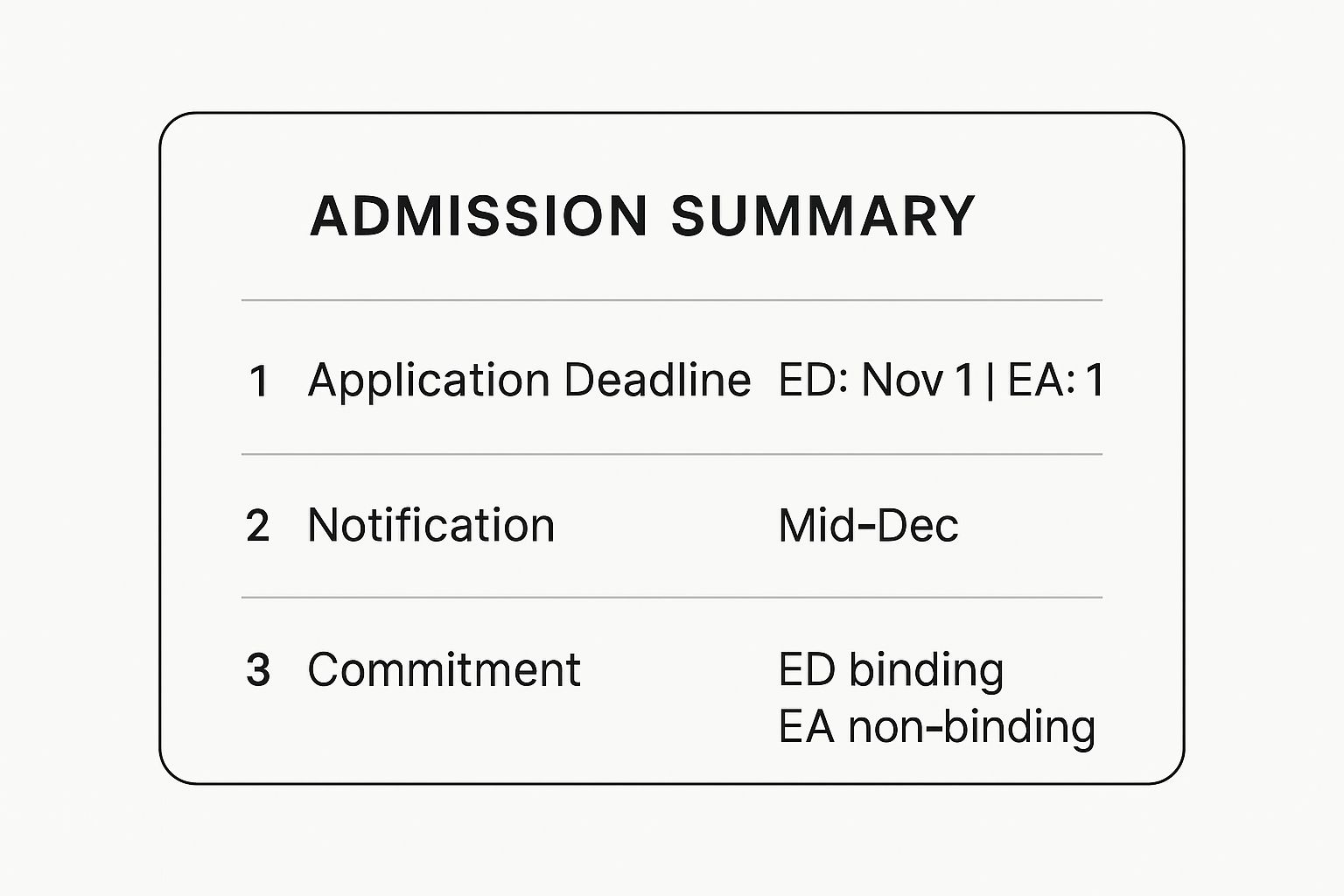
As the infographic shows, the deadlines might look similar, but that binding "yes" from an Early Decision acceptance changes the game completely.
The Curveball: Restrictive Early Action
Just to make things a little more complicated, some of the most selective schools have something called Restrictive Early Action (REA) or Single-Choice Early Action (SCEA). It’s still non-binding, but it comes with strings attached that limit where else you can apply early. For instance, a school might say you can't apply to any other private university's early plan.
Why do they do this? It’s their way of finding students who are genuinely serious about their school without locking them into a binding agreement. It’s a middle ground that lets you signal strong interest while still keeping some of your options open.
Across the country, about 450 colleges now offer some form of early plan. It's a strategic move on their part, and you need to be just as strategic. You can learn more about these facts on early application plans to get a better sense of the landscape.
What This Means For You and Your Teen
- Money Talks: If comparing financial aid offers is a must-do for your family, Early Decision is a massive gamble. Before even thinking about applying ED, you absolutely have to use the college's Net Price Calculator to get a ballpark idea of what you’ll be expected to pay.
- Read the Fine Print: Don’t just assume you know the rules. Every school’s early application plan is slightly different, especially when it comes to REA and SCEA policies. Read every word on their admissions site.
- Protect Your Mental Health: The weight of a binding decision can be crushing. This journey is about finding the right fit for the next four years, not just getting the fastest acceptance letter. For great resources on handling academic anxiety, check out organizations like The Jed Foundation, which offers fantastic support for teens.
Navigating the Mental and Emotional Journey

The college application process is a mental marathon, and the early decision vs early action choice adds a huge layer of emotional weight. For some students, getting that Early Decision acceptance is a massive relief. It lifts the burden of uncertainty and lets them actually enjoy their senior year. That clear finish line can be a powerful motivator.
But for others, the pressure of a binding commitment feels completely crushing. A choice this big can trigger procrastination—not because they're lazy, but because they’re terrified of making the wrong move. When a teen feels trapped by a decision, their motivation can disappear.
Fostering a Supportive Home Environment
As a parent, your most important job is to create a safe space for honest, judgment-free conversations. The goal here is to manage everyone's expectations—yours and your teen's—and to frame this decision as an act of empowerment, not a high-stakes test they can fail.
Here are a few ways to guide the journey:
- Validate Their Feelings: Acknowledge that this is a stressful and confusing time. Just saying, "I know this is a lot to handle, and it's okay to feel overwhelmed," can make a world of difference.
- Focus on Process, Not Outcome: Shift the conversation away from "getting in" and toward building a strong, authentic application they can feel proud of, no matter what happens. This takes the pressure off and quiets that performance anxiety.
- Watch for Burnout: Keep an eye out for changes in sleep, increased irritability, or pulling away from friends. These can be signs that the pressure is getting to be too much.
Open communication is everything. If you're looking for ways to support your teen's mental health, exploring strategies on how to reduce anxiety can give your family some valuable tools.
The most important question to ask your teen isn’t "Where do you want to go?" but "How do you feel about this choice?" Their emotional response will tell you more about their readiness for a binding commitment than any college ranking ever could.
Building Resilience and Finding Support
Ultimately, navigating the choice between early decision vs early action is an exercise in self-awareness. It forces a student to really understand their own tolerance for risk, how confident they are in their top choice, and whether they can handle potential disappointment.
For families who need more guidance, don't hesitate to lean on trusted mental health resources. Organizations like The Jed Foundation and the National Alliance on Mental Illness (NAMI) have programs and information specifically for the challenges teens and young adults are facing. Using these resources helps build resilience and ensures your teen's well-being stays the top priority through this demanding but rewarding chapter.
So, How Do You Choose?
Deciding between Early Decision and Early Action isn't about finding a secret back door into your dream college. It’s about being brutally honest with yourself—your academic standing, your family's finances, and your own readiness. The goal here is to pick a path that builds your confidence, not one that spikes your anxiety.
This is a really important conversation for parents and teens to have. Instead of obsessing over acceptance rates, the real talk should be about readiness and fit. If a student is already struggling with procrastination or motivation, the intense pressure of a binding ED agreement can be a recipe for disaster. In those situations, the flexibility of EA just makes more sense. It provides a healthier, more manageable way forward.
Who Is Early Decision Actually For?
Let's be clear: Early Decision is for a very specific type of student. You might be a perfect ED candidate if you check all these boxes:
- You have a hands-down, no-questions-asked dream school. You’ve done the campus tours, you’ve talked to students, you’ve researched it to death, and you can honestly say, “If I get in, I’m 100% going.”
- Your grades and scores are already solid. Your junior year GPA and test scores are already in the zone for that school’s admitted students. You don’t need your first-semester senior grades to bolster your application.
- Your family is ready for the price tag. You’ve run the numbers on the college’s Net Price Calculator and you're comfortable with the result. You don't need to compare financial aid packages from different schools to make it work.
That last point is huge. The binding nature of ED means you give up all your leverage to negotiate financial aid. For families who need to compare different offers, ED is a massive risk.
When Early Action Is The Smarter Move
Early Action gives you a strategic advantage without the all-or-nothing pressure. For most students, it's the better fit. Here's why:
- You want to keep your options open. You’ve got a few top-choice schools and you want the freedom to look at all your acceptance letters—and financial aid packages—side-by-side.
- You’re a strong applicant, but maybe not a shoo-in. EA is a great way to show a school you’re serious without being locked in if you get accepted. It signals strong interest without the binding commitment.
- You just need more time. Maybe you want to polish your essays, visit a few more campuses, or just feel more certain about your choice. EA gives you that breathing room until the national May 1 deadline.
Parenting Tip: The best way you can support your teen is by encouraging self-awareness. Ask them real questions, like, “How would you feel if you got into your ED school but the financial aid offer wasn't what we were hoping for?” or “What’s the biggest upside to keeping your options open with EA?” This gets them thinking about the real-world consequences, not just the dream.
The numbers don't lie—applying early does give you a real edge. Data from 2023 showed that at the most selective schools, ED applicants had a 60% higher acceptance rate than their Regular Decision counterparts. Even EA makes a difference; Harvard's early action rate for the Class of 2027 was 7.56%, more than double its overall 3.41% rate. You can learn more about the statistical advantages of applying early.
Choosing your application strategy takes some deep self-reflection, which is a skill that will serve you well in college and beyond. For more on how to build the personal qualities that colleges are really looking for, check out my guide on what got me into college. In the end, the right choice is the one that lets you put your best foot forward with confidence.
Tough Questions About Applying Early
As you get deeper into the Early Decision vs. Early Action debate, the "what ifs" start piling up. These aren't just hypotheticals; they're the real, practical questions that can make or break this entire process for a family. Let's get into it and tackle these concerns head-on.
It’s easy to get stuck here. These conversations can feel stressful, and it's tempting to just put them off. But framing these questions as strategic moves—not roadblocks—is key. Breaking down the big "what-ifs" gives you back a sense of control.
Can You Actually Break an Early Decision Agreement?
The short answer? Almost never. Think of an Early Decision agreement as a binding contract. Backing out isn’t just frowned upon; it has real consequences. Your high school guidance counselor, who also signs off on it, could refuse to send your final transcript to other schools. The ED college can also notify other institutions about what happened.
There is one major exception, though: a significant and provable change in your family's financial situation. If the financial aid package comes back and it's genuinely unaffordable because of a recent job loss or some other unexpected crisis, the college will usually release you from the agreement. But this has to be a substantial, documented issue—not just a case of getting cold feet or hoping for a better offer elsewhere.
Parenting Tip: This is exactly why you must use a college’s Net Price Calculator before ever committing to ED. Sit down with your teen and have a frank discussion about what your family can realistically afford. No one wants a devastating financial surprise in December.
Does Applying Early Hurt Your Chances for Financial Aid?
Applying early doesn't change the formulas colleges use to calculate aid, but applying Early Decision absolutely changes your leverage. If you get a non-binding Early Action acceptance, you can sit back and compare financial aid packages from several different schools. But with a binding ED acceptance, you get one offer. Take it or leave it.
This is the single biggest risk of applying ED. The college has no real incentive to put its best financial foot forward because they already have your commitment. The stress of being locked into an aid package that might not be enough can be a huge weight on both students and parents.
- Actionable Advice: Before going down the ED road, have a family meeting and set a firm budget. If the Net Price Calculator's estimate is already a stretch, ED probably isn't the right move. The mental toll isn't worth it. For families struggling with this kind of stress, organizations like the National Alliance on Mental Illness (NAMI) have great resources for teens and parents.
What If My Senior Year Grades Are Going to Be My Best?
This is a huge strategic question. If your academic record shows a solid upward trajectory—and you know your first-semester senior year grades are going to be your strongest yet—waiting for Regular Decision might be the smartest play. Admissions officers really do pay attention to that kind of progress.
When you apply Early Action or Early Decision, you're being judged almost entirely on your grades through the end of junior year. If you need that senior-year boost to push your application from the "maybe" pile to the "yes" pile, applying early might mean you're not showing them your best self. Sometimes, patience really does pay off.





